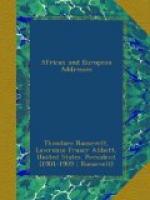The phenomena of national growth and decay, both of those which can and those which cannot be explained, have been peculiarly in evidence during the four centuries that have gone by since the discovery of America and the rounding of the Cape of Good Hope. These have been the four centuries of by far the most intense and constantly accelerating rapidity of movement and development that the world has yet seen. The movement has covered all the fields of human activity. It has witnessed an altogether unexampled spread of civilized mankind over the world, as well as an altogether unexampled advance in man’s dominion over nature; and this together with a literary and artistic activity to be matched in but one previous epoch. This period of extension and development has been that of one race, the so-called white race, or, to speak more accurately, the group of peoples living in Europe, who undoubtedly have a certain kinship of blood, who profess the Christian religion, and trace back their culture to Greece and Rome.
The memories of men are short, and it is easy to forget how brief is this period of unquestioned supremacy of the so-called white race. It is but a thing of yesterday. During the thousand years which went before the opening of this era of European supremacy, the attitude of Asia and Africa, of Hun and Mongol, Turk and Tartar, Arab and Moor, had on the whole been that of successful aggression against Europe. More than a century went by after the voyages of Columbus




